You are using an out of date browser. It may not display this or other websites correctly.
You should upgrade or use an alternative browser.
You should upgrade or use an alternative browser.
Dirt rally 2.0 TUNING
- Thread starter dejkoo
- 3 comments
- 9,753 views
- 111

- Slovenia
;
Attachments
-
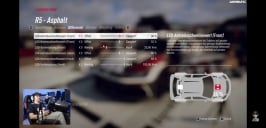 Screenshot_20190304_025844_com.google.android.youtube.jpg46.4 KB · Views: 552
Screenshot_20190304_025844_com.google.android.youtube.jpg46.4 KB · Views: 552 -
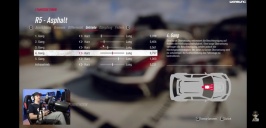 Screenshot_20190304_025858_com.google.android.youtube.jpg42.3 KB · Views: 501
Screenshot_20190304_025858_com.google.android.youtube.jpg42.3 KB · Views: 501 -
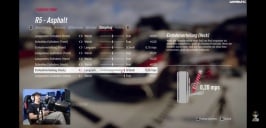 Screenshot_20190304_025912_com.google.android.youtube.jpg45.7 KB · Views: 466
Screenshot_20190304_025912_com.google.android.youtube.jpg45.7 KB · Views: 466 -
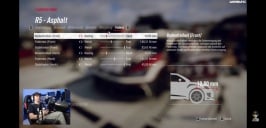 Screenshot_20190304_025921_com.google.android.youtube.jpg44.1 KB · Views: 467
Screenshot_20190304_025921_com.google.android.youtube.jpg44.1 KB · Views: 467 -
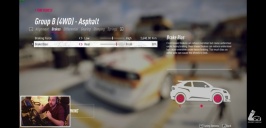 Screenshot_20190304_023447_com.google.android.youtube.jpg37.9 KB · Views: 448
Screenshot_20190304_023447_com.google.android.youtube.jpg37.9 KB · Views: 448 -
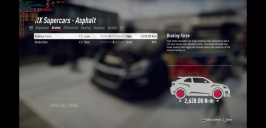 Screenshot_20190304_232950_com.google.android.youtube.jpg34.7 KB · Views: 446
Screenshot_20190304_232950_com.google.android.youtube.jpg34.7 KB · Views: 446 -
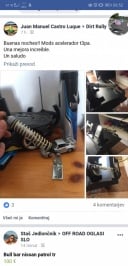 Screenshot_20190304_065206_com.android.chrome.jpg56.1 KB · Views: 446
Screenshot_20190304_065206_com.android.chrome.jpg56.1 KB · Views: 446 -
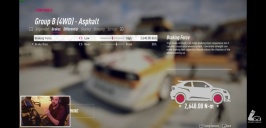 Screenshot_20190304_023617_com.google.android.youtube.jpg38.1 KB · Views: 442
Screenshot_20190304_023617_com.google.android.youtube.jpg38.1 KB · Views: 442 -
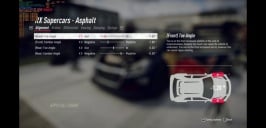 Screenshot_20190304_232957_com.google.android.youtube.jpg37.9 KB · Views: 448
Screenshot_20190304_232957_com.google.android.youtube.jpg37.9 KB · Views: 448 -
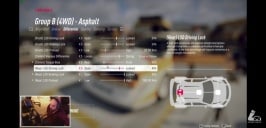 Screenshot_20190304_023754_com.google.android.youtube.jpg45 KB · Views: 433
Screenshot_20190304_023754_com.google.android.youtube.jpg45 KB · Views: 433 -
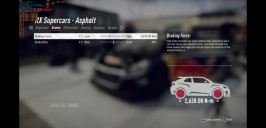 Screenshot_20190304_233000_com.google.android.youtube.jpg34.7 KB · Views: 429
Screenshot_20190304_233000_com.google.android.youtube.jpg34.7 KB · Views: 429 -
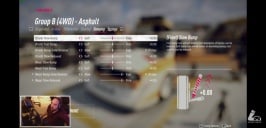 Screenshot_20190304_023824_com.google.android.youtube.jpg42 KB · Views: 431
Screenshot_20190304_023824_com.google.android.youtube.jpg42 KB · Views: 431 -
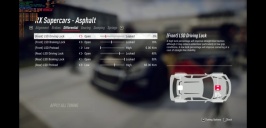 Screenshot_20190304_233003_com.google.android.youtube.jpg40.7 KB · Views: 406
Screenshot_20190304_233003_com.google.android.youtube.jpg40.7 KB · Views: 406 -
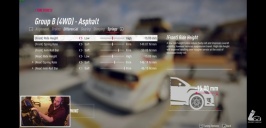 Screenshot_20190304_023840_com.google.android.youtube.jpg41.8 KB · Views: 417
Screenshot_20190304_023840_com.google.android.youtube.jpg41.8 KB · Views: 417 -
 Screenshot_20190304_233008_com.google.android.youtube.jpg38.6 KB · Views: 406
Screenshot_20190304_233008_com.google.android.youtube.jpg38.6 KB · Views: 406 -
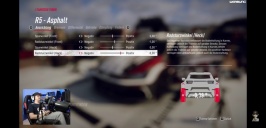 Screenshot_20190304_025825_com.google.android.youtube.jpg42.4 KB · Views: 426
Screenshot_20190304_025825_com.google.android.youtube.jpg42.4 KB · Views: 426 -
 Screenshot_20190304_233011_com.google.android.youtube.jpg39.3 KB · Views: 417
Screenshot_20190304_233011_com.google.android.youtube.jpg39.3 KB · Views: 417 -
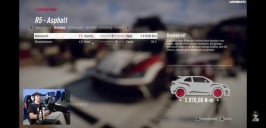 Screenshot_20190304_025833_com.google.android.youtube.jpg38.7 KB · Views: 423
Screenshot_20190304_025833_com.google.android.youtube.jpg38.7 KB · Views: 423 -
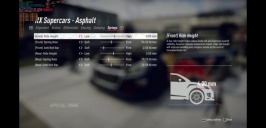 Screenshot_20190304_233013_com.google.android.youtube.jpg39.6 KB · Views: 484
Screenshot_20190304_233013_com.google.android.youtube.jpg39.6 KB · Views: 484
Maybe not interesting for all the knowledgeable sim racers but for me it is:
Camber, Caster, Toe-in/Toe-out, explained
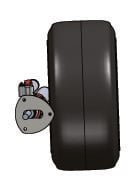
CAMBER
Probably is the most familiar term of the 3.
Camber is the angle of the wheels, relative to the road, looking at the car from the front (or rear).
Try to imagine a vertical line through the middle of the wheel
0 degrees camber is when this imaginary line is in square with the road. (black)
Positive camber occurs when the "middle-lines" are in "V-shape" (red line)
Negative camber occurs when the "middle-lines" are in "A-shape" (green line)
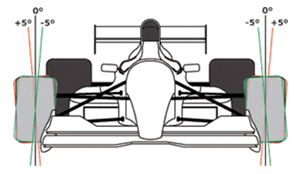
CASTER
Looking to the car from the side;
Imagine/draw an axis-line through the steering-turning-axis of the wheel.
Most of the times through the upper and lower ball-joints or through the
centreline of the McPherson-strut.
Positive caster occurs when the top of this axis-line tilts towards the rear of the
car. (green line), Negative caster is the opposite (red line)
Positive caster provides the self centring-force which makes the car go straight without holding the steering wheel.
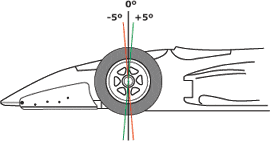
TOE-IN & TOE-OUT
Looking to the car from the top (or bottom) ;
Imagine lines through the middle of the wheels in riding direction.
TOE-IN occurs when these lines are in "A-shape", lines cross in front of the wheels. (red lines)
TOE-OUT occurs when these lines are in "V-shape"; lines cross behind wheels. (green lines)
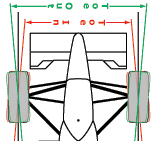
By now we hope you're "getting the big picture";
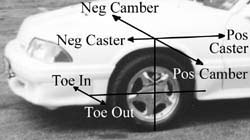
PART 2: What influence do CAMBER, CASTER, and TOE-IN/OUT have on the behaviour of the car?
CAMBER generally will be around - 0.5 to - 5.5 degrees. (negative)
When cornering the body of the car will start rolling, inducing positive camber. Negative camber will compensate for this effect.
Result: more grip and stability while cornering.
Also; negative camber creates a force on the wheels called "camber-thrust". Going straight Left and Right will be in balance and the car goes straight.
Result; better straight stability with more negative camber.
When cornering the inner wheel will be lifted from a little too sometimes completely. Than the camber-thrust will cause the car to make a sharper turn, pushing the car inwards.
Result; Better cornering
That's why car-designers try to keep about 0.5-degree negative camber while cornering with the suspension being compressed. That means that the negative-camber at ride height will become more negative when the suspension compresses, at the same time the body roll will eat up negative camber. Hopefully leaving a bit of negative for Cornering-grip and better steering and even heating of the tires as well as even tire-wear.
Question; Is Negative-Camber always a positive thing?
Answer; No
Why; It will cause tire-wear on the inner-side of the tyres going straight.
Ideal would be that the tires are always perpendicular to the road under all circumstances.
For a saloon car, this will be harder than for a race car, because of more wheel-travel, softer suspension, more body-roll.
Also, tire wear should be economical with a saloon-/street-car. Racers have more budget for tires.........most of the times.
So a compromise has to be made;
Most of the times this will be between 0.5 and 2.0 degrees negative camber.
On most streetcars, camber is rather difficult to adjust.
Except if you use Intrax camber-plates than camber can be adjusted in a few seconds.
CASTER (or CASTOR)
Generally will be between +2 and 5.5 degrees, positive.
Only applies to the front-/steering-wheels.
Caster is needed to create straight-line stability or one could say "directional steering stability"
In order to understand what the effect of caster is we can take the front-wheels of a shopping cart.
These wheels do have positive caster and because of that, they will go in the direction where you push the cart.
If you would turn these wheels 180 degrees than they would have negative caster.
Pushing the cart now will be a lot more difficult and at the same time very unpredictable/unstable.
Positive caster will also affect camber when steering;
The outer wheel will get more negative camber as the inner wheel's camber will get less negative.
The more positive caster the more "feedback" you will feel driving the car, especially with a force feedback wheel.
One could think, "the more positive caster the better" but that's not really the case.
It would make steering harder as the steering force will increase.
Also, there's another disadvantage;
While steering; positive caster will cause the inner wheel to rise and the outer wheel will drop.
This again will transfer "corner-weight" from the inner to the outer wheel, causing a loose feeling in the car.
Normally it's not so easy to adjust caster on a car but using Intrax camber-plates also makes the caster adjustable.
TOE-IN / TOE-OUT
Affects 3 major areas; Tire wear, straight-line stability and corner entry handling.
For minimum tire-wear, it would be ideal to have the wheels parallel / 0 degrees while riding.
This can be accomplished to give a bit static toe-out to a front-wheel-drive car, or toe-in to a rear-wheel-drive.
A front-wheel-drive car has a tendency to understeer.
Toe-out will induce a bit of oversteer, so it could compensate for the front wheel drivers understeer.
Excessive toe-in will cause the tire to scrub on the outboards and so will shorten the tire-life.
Too much toe-out will cause the inboard edges to wear out.
Steering response will be improved with toe-out.
Straight line stability will be improved with toe-in.
Sometimes toe-in or toe-out is used for another effect; Tire-temperature.
For racing-tires it's very important to reach a certain temperature in order to deliver maximum performance/grip.
If the tires stay too cool than toe can be used for the "scrubbing" effect,
The scrubbing also has another positive effect; It will scrub the tires clean providing extra grip for braking and cornering.
Streetcars often are set up with toe-in; For good straight-line stability, cornering is sacrificed.
Race cars are often set up with toe-out; Straight-line stability is sacrificed for good cornering.
If the suspension is independent; Toe-in or -out can also be applied to the rear-wheels. The effect on the rear-wheels is generally the same as on the front.
Also, there's a difference between the static and dynamic toe. Especially on a front-wheel-driver you see this happening.
The same goes for a rear wheel-driver with independent suspension left and rear.
What happens is that when torque is applied; The driven wheels pull themselves forward trying to toe-in.
Now it depends on the construction of the suspension how much the toe-in will increase.
On streetcars, this effect is a lot bigger than on race cars as they use softer rubber bushings in the suspension-joints.
These provide more comfort and "kill" more noise but doing so sacrifice precision and stiffness.
CONCLUSION:
All the above is of great importance on the handeling of the car. as well as the level of satisfaction of the driver.
So if possible use factory settings or settings who have proven to be good, as a starting point for a new setup with new springs, shocks, and/or camber-plates on your car.
Investing a vast amount of money in new shocks and not lining the wheels again in a proffesional workshop, could make your suspension-investment absolete!
It could be that you do not feel any improvement of the suspension upgrade. Also, your car can easily become unsafe on a straigth, during cornering and/or under braking.
Also, we hope you understand more about the lining of a car and at the same time are aware of the importance of it.
We wish you lots of safe riding-pleasure!
Camber, Caster, Toe-in/Toe-out, explained

CAMBER
Probably is the most familiar term of the 3.
Camber is the angle of the wheels, relative to the road, looking at the car from the front (or rear).
Try to imagine a vertical line through the middle of the wheel
0 degrees camber is when this imaginary line is in square with the road. (black)
Positive camber occurs when the "middle-lines" are in "V-shape" (red line)
Negative camber occurs when the "middle-lines" are in "A-shape" (green line)

CASTER
Looking to the car from the side;
Imagine/draw an axis-line through the steering-turning-axis of the wheel.
Most of the times through the upper and lower ball-joints or through the
centreline of the McPherson-strut.
Positive caster occurs when the top of this axis-line tilts towards the rear of the
car. (green line), Negative caster is the opposite (red line)
Positive caster provides the self centring-force which makes the car go straight without holding the steering wheel.

TOE-IN & TOE-OUT
Looking to the car from the top (or bottom) ;
Imagine lines through the middle of the wheels in riding direction.
TOE-IN occurs when these lines are in "A-shape", lines cross in front of the wheels. (red lines)
TOE-OUT occurs when these lines are in "V-shape"; lines cross behind wheels. (green lines)

By now we hope you're "getting the big picture";

PART 2: What influence do CAMBER, CASTER, and TOE-IN/OUT have on the behaviour of the car?
CAMBER generally will be around - 0.5 to - 5.5 degrees. (negative)
When cornering the body of the car will start rolling, inducing positive camber. Negative camber will compensate for this effect.
Result: more grip and stability while cornering.
Also; negative camber creates a force on the wheels called "camber-thrust". Going straight Left and Right will be in balance and the car goes straight.
Result; better straight stability with more negative camber.
When cornering the inner wheel will be lifted from a little too sometimes completely. Than the camber-thrust will cause the car to make a sharper turn, pushing the car inwards.
Result; Better cornering
That's why car-designers try to keep about 0.5-degree negative camber while cornering with the suspension being compressed. That means that the negative-camber at ride height will become more negative when the suspension compresses, at the same time the body roll will eat up negative camber. Hopefully leaving a bit of negative for Cornering-grip and better steering and even heating of the tires as well as even tire-wear.
Question; Is Negative-Camber always a positive thing?
Answer; No
Why; It will cause tire-wear on the inner-side of the tyres going straight.
Ideal would be that the tires are always perpendicular to the road under all circumstances.
For a saloon car, this will be harder than for a race car, because of more wheel-travel, softer suspension, more body-roll.
Also, tire wear should be economical with a saloon-/street-car. Racers have more budget for tires.........most of the times.
So a compromise has to be made;
Most of the times this will be between 0.5 and 2.0 degrees negative camber.
On most streetcars, camber is rather difficult to adjust.
Except if you use Intrax camber-plates than camber can be adjusted in a few seconds.
CASTER (or CASTOR)
Generally will be between +2 and 5.5 degrees, positive.
Only applies to the front-/steering-wheels.
Caster is needed to create straight-line stability or one could say "directional steering stability"
In order to understand what the effect of caster is we can take the front-wheels of a shopping cart.
These wheels do have positive caster and because of that, they will go in the direction where you push the cart.
If you would turn these wheels 180 degrees than they would have negative caster.
Pushing the cart now will be a lot more difficult and at the same time very unpredictable/unstable.
Positive caster will also affect camber when steering;
The outer wheel will get more negative camber as the inner wheel's camber will get less negative.
The more positive caster the more "feedback" you will feel driving the car, especially with a force feedback wheel.
One could think, "the more positive caster the better" but that's not really the case.
It would make steering harder as the steering force will increase.
Also, there's another disadvantage;
While steering; positive caster will cause the inner wheel to rise and the outer wheel will drop.
This again will transfer "corner-weight" from the inner to the outer wheel, causing a loose feeling in the car.
Normally it's not so easy to adjust caster on a car but using Intrax camber-plates also makes the caster adjustable.
TOE-IN / TOE-OUT
Affects 3 major areas; Tire wear, straight-line stability and corner entry handling.
For minimum tire-wear, it would be ideal to have the wheels parallel / 0 degrees while riding.
This can be accomplished to give a bit static toe-out to a front-wheel-drive car, or toe-in to a rear-wheel-drive.
A front-wheel-drive car has a tendency to understeer.
Toe-out will induce a bit of oversteer, so it could compensate for the front wheel drivers understeer.
Excessive toe-in will cause the tire to scrub on the outboards and so will shorten the tire-life.
Too much toe-out will cause the inboard edges to wear out.
Steering response will be improved with toe-out.
Straight line stability will be improved with toe-in.
Sometimes toe-in or toe-out is used for another effect; Tire-temperature.
For racing-tires it's very important to reach a certain temperature in order to deliver maximum performance/grip.
If the tires stay too cool than toe can be used for the "scrubbing" effect,
The scrubbing also has another positive effect; It will scrub the tires clean providing extra grip for braking and cornering.
Streetcars often are set up with toe-in; For good straight-line stability, cornering is sacrificed.
Race cars are often set up with toe-out; Straight-line stability is sacrificed for good cornering.
If the suspension is independent; Toe-in or -out can also be applied to the rear-wheels. The effect on the rear-wheels is generally the same as on the front.
Also, there's a difference between the static and dynamic toe. Especially on a front-wheel-driver you see this happening.
The same goes for a rear wheel-driver with independent suspension left and rear.
What happens is that when torque is applied; The driven wheels pull themselves forward trying to toe-in.
Now it depends on the construction of the suspension how much the toe-in will increase.
On streetcars, this effect is a lot bigger than on race cars as they use softer rubber bushings in the suspension-joints.
These provide more comfort and "kill" more noise but doing so sacrifice precision and stiffness.
CONCLUSION:
All the above is of great importance on the handeling of the car. as well as the level of satisfaction of the driver.
So if possible use factory settings or settings who have proven to be good, as a starting point for a new setup with new springs, shocks, and/or camber-plates on your car.
Investing a vast amount of money in new shocks and not lining the wheels again in a proffesional workshop, could make your suspension-investment absolete!
It could be that you do not feel any improvement of the suspension upgrade. Also, your car can easily become unsafe on a straigth, during cornering and/or under braking.
Also, we hope you understand more about the lining of a car and at the same time are aware of the importance of it.
We wish you lots of safe riding-pleasure!
Last edited:
Similar threads
- Replies
- 25
- Views
- 10K
Latest Posts
-
Skoda is Coming to Gran Turismo 7, Vision GT Car to be Revealed Next Week
- Latest: Canucks_9419
-
-
-
-

